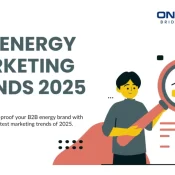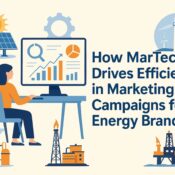
B2B Energy Marketing Trends 2025
Top B2B Energy Marketing Trends in 2025 to Accelerate Growth & Lead Generation
In 2025, B2B energy marketing will be driven by AI-powered personalization, ESG commitments, and data-driven campaigns. The energy sector is buzzing with opportunities. The International Energy Agency (IEA) predicts global energy investment will soar to $2.8 trillion by 2025, with renewables and grid modernization leading the way (IEA, World Energy Investment 2024). But here’s the twist: energy buyers—like utilities, manufacturers, or municipalities—are more informed than ever. They’re managing tight budgets, ESG requirements, and complex tech choices. That’s where savvy B2B marketing steps in, helping you cut through the clutter and connect with the key decision-makers who matter.
In this comprehensive guide to B2B energy marketing in 2025, we’ll explore trends, tools, and tactics to help you thrive!
Top B2B Energy Marketing Trends for 2025
1. Hyper-Personalization Powered by AI
Energy buyers are not a one-size-fits-all group. A utility executive focused on grid reliability has different concerns than a factory manager looking at solar ROI. In 2025, hyper-personalization—using AI to customize content based on data—will be essential.
Gartner forecasts that by 2025, 80% of B2B marketers employing personalized campaigns will experience a 30% increase in engagement (Gartner, 2024 Marketing Trends).
• Update: AI analyzes client data—like previous purchases or energy consumption—to create tailored pitches. Imagine personalized emails or landing pages that directly address a client’s specific challenges.
• Example: A battery storage provider could leverage AI to propose a customized solution for a hospital, emphasizing outage protection based on its unique power requirements.
Dive into your CRM data to categorize clients by industry or objectives. Design campaigns that feel like personal conversations rather than generic outreach.
2. Sustainability as Your Brand’s Backbone
Sustainability isn’t just a passing trend; it’s become a necessity.
By 2025, a whopping 60% of B2B energy buyers will be on the lookout for vendors with solid ESG credentials, according to a Deloitte survey (Deloitte, 2024 Sustainability Report).
Whether it’s wind turbines or energy management software, clients are eager to partner with those who genuinely commit to net-zero goals.
• Update: Companies that can demonstrate real ESG impact—like reducing emissions or utilizing recycled materials—are the ones sealing the deals. Green marketing is all about being authentic, not just throwing around buzzwords.
• Example: A solar developer could share a case study illustrating how their panels reduced a factory’s carbon footprint by 40%.
Take a close look at your operations for ESG successes, and weave those stories into your narrative. Creating blogs, videos, or LinkedIn posts about your green initiatives can help build trust and attract eco-conscious clients.
3. Video Content to Simplify Complex Solutions
Energy technology can be pretty complicated—think hydrogen fuel cells or smart grids. That’s why video is becoming the go-to medium in 2025.
Sixty-nine percent of B2B marketers said they would increase their investment in video in 2024, followed by thought leadership content (53%), in-person events (47%) and other tactics, according to the Content Marketing Institute’s 14th Annual Content Marketing Survey.
Short demos, client testimonials, or animated explainers can really make your offerings resonate.
• Update: Videos can break down complex jargon into visuals that buyers can easily understand.
• Example: An energy analytics firm might produce a 90-second video demonstrating how their software optimizes wind farm output in real time.
Invest in a few high-quality videos that showcase your solutions. Share them on LinkedIn and your website to enhance engagement and speed up sales cycles.
4. Account-Based Marketing (ABM) for Big Wins
Energy deals are often high-stakes, involving multi-year contracts and hefty budgets. That’s where ABM comes in—it’s all about targeting specific accounts with customized campaigns, making it a perfect fit for this industry.
According to Forrester, a whopping 92% of B2B marketers who use ABM see a better ROI compared to traditional methods (Forrester, 2024 ABM Benchmark Study).
• Update: ABM zeroes in on key accounts, such as utilities or industrial plants, delivering personalized content tailored to each stakeholder—whether they’re executives, engineers, or procurement teams.
• Example: A gas turbine supplier might send a CFO a report highlighting cost savings while inviting engineers to a technical webinar.
Identify 5–10 dream clients and chart out their decision-makers. Use targeted emails, demos, or whitepapers to guide them toward closing a deal.
5. Thought Leadership Through Hybrid Events
Trade shows like RE+ or DistribuTECH are making a comeback, but hybrid events—blending in-person and virtual experiences—are paving the way for the future. They allow you to connect with global audiences while showcasing your expertise.
70% of B2B buyers conduct research online before making a decision, emphasizing the importance of thought leadership and digital engagement in B2B sales (McKinsey, 2024 B2B Buyer Survey).
• Update: By hosting webinars or speaking at conferences, you can establish yourself as a trusted expert. Creating blogs and whitepapers on trending topics, such as energy storage or policy changes, can amplify your message.
• Example: A microgrid company could organize a hybrid panel discussion on urban energy resilience, streaming it to potential clients around the world.
Mix up your events—think virtual webinars, in-person booths, or LinkedIn Live sessions—to share valuable insights and generate leads.
Proven Strategies to Grow Your B2B Energy Business in 2025
1) Utilize Data for Precision
: Dive into analytics to uncover what your clients really need—whether it’s a push for renewable energy or necessary grid upgrades. Tailor your campaigns to tackle those specific challenges.2) Enhance Your ESG Impact
: Make sure to showcase your sustainability achievements across all your content—be it your website, blogs, or social media posts. This builds trust and helps close deals.3) Invest in Video
: Set aside a budget for high-quality videos that highlight the value of your technology. A demonstration of your EV charging network can clinch a deal much quicker than just text alone.4) Initiate ABM Campaigns
: Zero in on your top-tier accounts with customized pitches. Keep an eye on engagement to fine-tune your strategy and maximize your successes.5) Share Your Expertise
: Share whitepapers or organize events around trending topics like battery storage or green hydrogen. This approach acts as a lead magnet that keeps on giving.
The Role of Multi-Channel Marketing in Energy Growth
If you want to stand out in 2025, embracing a multi-channel strategy is key to expanding your reach and generating leads. Invest in
1. SEO: Your Traffic Powerhouse
SEO is essential for boosting your visibility online. Securing the top position for high-traffic keywords in your niche can bring in thousands of targeted visitors. BrightEdge highlights that organic search is responsible for 53% of B2B traffic (BrightEdge, 2024 SEO Trends).
Make sure your website is optimized with keyword-rich blogs (like this one!), quick-loading pages, and backlinks from trusted industry sites like Energy Central. Utilize tools like SEMrush to keep an eye on your rankings and spot any gaps.
Don’t forget to audit your site’s SEO health regularly. Aim to publish 2–3 blogs each month on trending topics like grid modernization or ESG, focusing on keywords that get over 1,000 searches a month.
2. Social Media: Building Trust and Reach
LinkedIn and Twitter are fantastic resources for energy marketers. Hootsuite’s 2024 Social Media Report reveals that LinkedIn drives 46% of B2B social traffic. By sharing valuable insights or engaging with potential clients, you can build strong relationships.
Think about posting case studies, videos, or polls on LinkedIn that showcase energy innovations. Also, join Twitter chats with the hashtag #CleanEnergy to connect with influential voices in the field.
Aim to schedule 3 to 5 posts each week on both LinkedIn and Twitter. Hootsuite can help you manage and keep track of your engagement.
3. Paid Advertising: Precision Targeting
Paid ads—whether it’s Google Ads, LinkedIn Ads, or retargeting—offer immediate visibility. B2B marketers who use LinkedIn Ads experience click-through rates that are 25% higher than those on other platforms, as noted in LinkedIn’s 2024 Ads Benchmark.
You might want to run Google Ads targeting keywords like “energy storage solutions” or use LinkedIn Ads aimed at utility executives. Additionally, retarget visitors to your website with customized offers.
Start with a chosen monthly ad budget, dividing it between Google and LinkedIn. Experiment with different ad copy and refine your approach based on what converts best.
4. Email Marketing: Nurturing Long Sales Cycles
When it comes to energy deals, patience is key—they can take anywhere from 6 to 12 months to close. That’s where email comes in, helping you stay at the forefront of your clients’ minds. According to Mailchimp, segmented email campaigns can increase open rates by a whopping 30% (Mailchimp, 2024 Email Stats).
Consider sending out personalized drip campaigns that include case studies, webinars, or ROI calculators. Tailor your content based on the recipient’s role—executives might appreciate strategy-focused content, while engineers would benefit from technical specifications.
You can create a nurturing sequence using tools like HubSpot or Pardot. Aim to send 2-4 emails each month for each segment, making sure to include clear calls to action.
5. Content Marketing: Fueling Thought Leadership
To build your authority, consider using blogs, whitepapers, and webinars. The Content Marketing Institute’s 2024 B2B Report reveals that content generates 67% of B2B leads. You could write in-depth blogs on topics like hydrogen trends or grid resilience. Offering gated content, such as a net-zero guide, is another effective way to gather email ids. It’s a good idea to create a content calendar that includes one blog, one whitepaper, and one webinar each quarter. And remember to promote your content on all your channels!
Must-Have Martech Tools for 2025 your marketing growth
These tools streamline your multi-channel strategy and maximize impact:
1) Salesforce Marketing Cloud (salesforce.com)
- Why: It powers personalized emails, automation, and integrates seamlessly with CRM systems.
- Energy Use: Send tailored utility content about grid upgrades based on what users have been browsing.
2) HubSpot (hubspot.com)
- Why: It’s an all-in-one solution for email, SEO, and lead tracking, perfect for mid-sized businesses.
- Energy Use: Automate a nurturing campaign for a solar lead using case studies.
3) Demandbase (demandbase.com)
- Why: This is an ABM platform designed to target high-value accounts with precision.
- Energy Use: Create a pitch for a wind developer with custom content tailored for executives and tech teams.
4) SEMrush (semrush.com)
- Why: It helps track keywords, competitors, and overall SEO performance.
- Energy Use: Optimize blog posts for “renewable energy solutions” to achieve a #1 ranking.
5) Canva Enterprise (canva.com)
- Why: It allows you to create videos, infographics, and pitch decks quickly.
- Energy Use: Design a video highlighting the benefits of EV chargers for LinkedIn.
In a Nutshell…
This is your year to shine in B2B energy marketing! By diving into AI personalization, focusing on ESG, creating engaging videos, utilizing account-based marketing, and establishing thought leadership, you’ll connect with buyers like never before. Combine that with a multi-channel approach—SEO for driving traffic, social media for building trust, ads for expanding your reach, email for nurturing leads, and content for showcasing authority—and you’re all set for rapid growth.
Ready to make waves in 2025? Check out onemindmartech.com/contact to book a chat. Let’s craft a plan that will make your energy business truly unstoppable.




